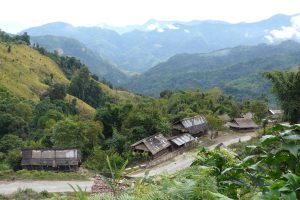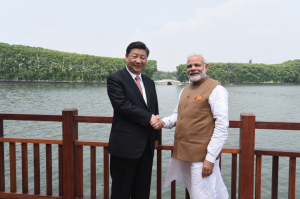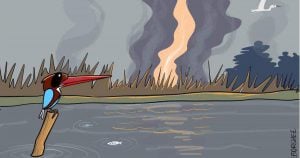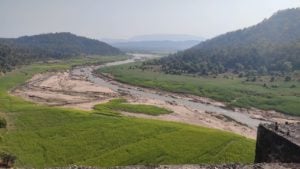When mountaineer Ed Douglas arrived in India’s Garhwal region to ascend a mountain called Shivling, he had a moment of profound realisation. Local travellers who visited the legendary peak were not climbers but pilgrims, paying homage to a small glacial stream: the source of the Ganga. Mountains are a western obsession, writes Douglas in his richly detailed book Himalaya: A Human History. For people in the region, rivers are what matter. A “life-giver and life-taker”, water is the ultimate architect of the Himalayas, sculpting the mountains and shaping history.
The Himalayan watershed is on the cusp of change. In November, China announced a plan to build the world’s largest dam in the Yarlung Tsangpo gorge. At a spot called the Great Bend, the river loops around one of the tallest peaks in the Himalayas before crossing into India. The Great Bend is the “final frontier” for dam builders, one of the last great untapped sources of hydropower. The chairman of the state-owned construction giant PowerChina called the 60-gigawatt mega-dam “a historic opportunity” that would help usher in a zero-carbon future by 2060, although it was perceived differently in downstream India.
Then on February 7, an avalanche tore through Garhwal, kicking up a cloud of ice and dust so thick it was visible from space. A tributary of the Ganga instantly turned into a lake. Swept away in the glacial deluge were two small hydroelectric projects, part of a burgeoning network of dams spanning the upper reaches of rivers in Garhwal. More than 200 people are missing and 72 bodies have been recovered
Missing voices from the Himalayas
Himalaya: A Human History is a book that meets this moment. As nations and nature reshape the landscape of the highest range, Himalayan voices are too often dismissed. Douglas asks the pertinent question: “Why was it that stories about climbing Everest were far more common than stories about the people who lived in its shadow?” The author bridges the gap by narrating little-known histories about places like Lhasa, Kathmandu, or Darjeeling. Among the recurrent threads is a story of the Yarlung Tsangpo.
When Nain Singh, a surveyor for India’s colonial government, first encountered the river in the 1860s, he watched in horror as three men drowned when their coracle overturned. The Yarlung Zangbo (Chinese spelling), known as Brahmaputra as it flows into India, may not be as famous as the Yangtze or the Zhujiang. But the river was feared and revered in the eastern Himalayas.
Birthplace of Tibetan identity
For Tibetans, the Tsangpo (as they call it) was part of their sacred geography. In the early 1800s, Jampel Chokyi Tenzin, the lama of Serkhok monastery, wrote a book on how Tibet viewed the world. Contained within the encyclopaedic text was an intriguing detail. The Tsangpo was, in fact, the upper course of a legendary Indian river. Despite that, Douglas notes, the British continued to “sweat” over the source of the Brahmaputra “for decades to come”.
The Yarlung Valley was the birthplace of Tibetan identity. According to ancient texts, the first king dropped down to earth “on the end of a sky-cord” and landed on Yarlha Shampo, a sacred mountain in the river valley. In the seventh century, Tibet underwent a remarkable transformation when feuding clans came together to form the Yarlung dynasty. At its height, their empire stretched from Central Asia to Myanmar and, at one point, occupied the Chinese capital at Chang’an. The Yarlung kings made Buddhism the state religion and introduced a new alphabet, a “watershed moment”. Far from being a “blank on the map”, southern Tibet was “part of a Himalayan network of cultures linking two of the most populous regions on earth, India and China”.
During colonial times, the Tsangpo gorge captured the imagination of adventure-seeking Europeans determined to go where “no white man has ever been”. Early explorers who ventured into the “fabled” canyon were plant hunters. English botanist Frank Kingdon-Ward wrote the popular book, The Riddle of the Tsangpo Gorges, which attempted to explain how the Brahmaputra River rapidly dropped from the roof of the world to the plains of Assam. As Douglas points out, Tibetan scholars had already connected some of the dots to that mystery. A few decades ago satellite photos revealed the epic scale of the river’s 2,740-metre cascade into the gorge.
Incredible biodiversity
Kingdon-Ward ventured up the Tsangpo in 1924 on the lookout for something much smaller. When the explorer first spotted the Himalayan blue poppy in its natural habitat, “he thought at first he’d seen the plumage of some fabulous bird.” He brought the seeds back to England, and the flower went on display at the Chelsea Flower Show. The Himalayan poppy captivated the public but proved “fiendishly difficult to grow”.
![Himalayan blue poppy [image by:: Debu55y / Shutterstock]](https://dialogue.earth/content/uploads/2021/03/Blue-poppy.png)
Although the British expedition took place a century ago, Douglas reminds us that the eastern Himalayas’ “astonishing” biodiversity is still mostly intact. High mountains and copious monsoons have preserved lush forests with varied microclimates hospitable to tigers, rhinos and elephants. And, of course, the blue poppy.
Complex relationships
The history of the Himalaya is replete with tales on how sharing the bounty of the world’s highest mountain range has always been complicated: “The needs of locals are often at odds with strategic interests of wealthier regions far away, and centers of power that in the past wanted Himalayan gold or musk now want hydroelectricity or border security.”
Early in his book, Douglas writes, “I wanted to reconcile what had brought me to the Himalaya with what I found there.” He admits that over time, “my own narrow perspective shattered into a million ways of seeing.” His romantic ambition to scale the highest mountains seemed “a strange luxury” when local needs were more down to earth. Even in 1949, the Tibetan government, headed by the Dalai Lama, talked to General Electric about potential hydropower projects. At present, there are about 500 Himalayan dam projects in the pipeline in five countries. Concrete evidence that rivers will continue to dominate the future of human activity in the Himalayas.
![<p>Prayer flags and the Machermo Range from Gokyo Ri, Nepal [image by: Peter Carey / Alamy]</p>](https://dialogue.earth/content/uploads/2021/02/DT865R.jpg)








